Temples in Bengaluru
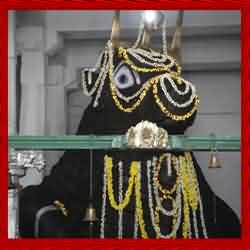 Bull Temple at Basavanagudi
Bull Temple at Basavanagudi
The Bull temple of Bangalore is dedicated to Nandi Bull, the vahana (vehicle) of Lord Shiva. Situated in Basavanagudi, this temple has been built in the Dravidian style of architecture. Kempe Gowda, the founder of Bangalore, got the Bull temple built during his time. This temple counts amongst the oldest temples of the city and draws devotees from all over the country. Read on to know more about the Bull Temple of Bangalore, India.
There is huge idol of Nandi Bull inside the temple, measuring 4.5 m in height and 6.5 m in length. This idol is said to have been carved out of a single rock. The bull also has a small iron plate on its head. As per the tradition, this plate prevents the bull from growing. Providing a great backdrop to the statue are the idols of God Surya and Goddess Chandra, on their chariots. It is believed that the Vishva Bharti River originates at the feet of this statue.
The legend goes that the Bull Temple was built to appease a bull that used to consume and destroy all the groundnuts and peanuts cultivated in this area. It is also said that after the temple was built, the bull stopped damaging the crop. As a celebration of this incident, the farmers of Basavanagudi organized a Groundnut Fair (Kadalekai Parase), near the temple. This fair continues till date and is attended by the people of Bangalore in large numbers.

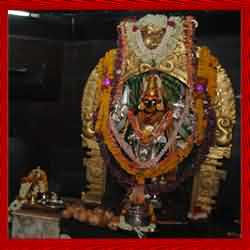 Banashankari Temple on Kanakapura Road
Banashankari Temple on Kanakapura Road
The Banashankari temple of Bangalore dates back to the year 1915. It was founded by Somanna Shetty, a devotee of Banashankari Amma. He brought a deity of Amma from Badami, in Bijapur district, and installed it inside the temple. Situated on the Kanakapura Road, the temple now comes under the management and control of the Endowment Department of the Government of Karnataka. Given below is more information on the Banashankari Temple of Bangalore, India.
One of the unique features of this temple is that the deity is worshipped in Rahukala, considered to be an inauspicious time according to Hindus. It is believed that worshipping Banashankari Amma in Rahukala rids one of all the hardships and paucities in life. There is a large rush of devotees in the temple, especially on Tuesdays, Fridays and Sundays, considered to quite auspicious for doing puja. The prayers are offered by lighting multiple oil lamps in half cut lemon peels, whose pulp has been removed.
Three cultural ceremonies are held at the Banashankari temple of Bangalore, every year. The first ceremony, commemorating the birth anniversary of Banashankari Amma, is held on 13th September. The second one is held as a celebration of the Dussehra festival, in October-November. The third, and the last, ceremony is held in the last week of December or the first week of January, to mark the anniversary of the temple.

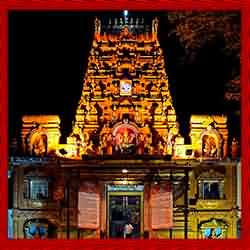 Kadu Mallikarjunaswamy Temple at Malleshwaram
Kadu Mallikarjunaswamy Temple at Malleshwaram
Kadu Malleswara Temple, situated at Malleswaram in Bangalore is an ancient historic temple dedicated to Lord Shiva. It is also known as Kaadu Mallikarjuna Swamy Temple and the preciding deity is Lord Shiva worshipped as Mallikarjuna Swamy.History of the temple dates back to the kith of Chatrapati Shivaji. The word ‘kadu’ literally means forest, referring to the thick vegetation that marked the surrounding places. Malleswaram suburb derives its name after this temple.The temple is now part of Archeaological Department of India and is a very popular landmark for old timers of Bangalore.The yearly chariot festival, the Mahashivaratri celebrations invite a huge crowd of devotees.
Kadu Mallikarjunaswamy temple located in Malleswaram, is one of the oldest temples in the city. There is no document of exact date or period of this temple. History shows that this temple had a relation with the period of the Great Maratha leader Shivaji.

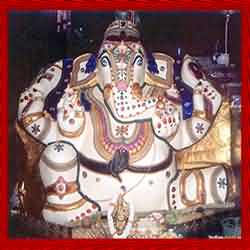 Dodda Ganesha Temple at Basavanagudi
Dodda Ganesha Temple at Basavanagudi
The monolithic Ganesha is about 18 ft in height and 16 ft in width. The God is also known as Shakthi Ganapathi or Satya Ganapathi. People from all walks of life come here to seek blessings. What makes this idol more attractive to the devotees is, the different types of decorations that are done during the week. The most famous is the butter coating of the idol. More than 100 kgs of butter is used for this purpose. is situated in the N.R. Colony, Basavanagudi, area of South Bangalore, part of the largest city of the Indian state of Karnataka. The Hindu temple is situated inside the boundaries of a park called "Bugle Rock". The bull referred to is a sacred Hindu demi-god, known as Nandi; Nandi is a close devotee and attendant of Shiva. Dodda Basavana Gudi is said to be the biggest temple to Nandi in the world. The stone cult image of Nandi is continually covered with new layers of butter, benne in the local language of Kannada. There is also a cult image of the elephant-headed Hindu deity Ganesha close by. This article discusses the adherents of Hinduism.... For other uses, see Shiva (disambiguation).... Every year on the last Monday and Tuesday of the hindu month of Karthika Maasa a Groundnut fair is held in the temple premisis and groundnut is offered to the deity. This fair is known as "Kadalekaayi Parishe" in local tongue. Groundnut sellers and devotees throng the place during "Kadalekaayi Parishe".

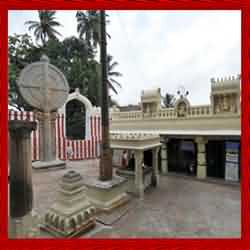 Gavi Gangadareshwara Temple
Gavi Gangadareshwara Temple
This temple, also located near Basavanagudi, is well known for its remarkable architecture. The Gavi Gangadhareshwara temple is one of the oldest temples in Bangalore. Legend has it that the cave temple dates back to the Tretha Yuga. Kempegowda built two of the oldest temples in Bangalore: the Bull temple and the Gavi Gangadareshwara Temple. The temple, dedicated to Lord Shiva and Goddess Parvathi is inside a natural cave in Gavipuram. Legend has it that Kempegowda built this temple in gratitude after being released from his five-year imprisonment by Rama Raya. Devotees gather here on Makara Sankaranti day when it is believed that at a particular moment in the evening the sun's rays fall directly on the linga inside the cave, passing between Nandi's horns. The temple, which roughly covers an area of 300 ft by 200 ft, was renovated during the period of the local chieftain Kempegowda, who is also known as the founder of Bangalore. This dates the temple back to nearly 500 years. The 14-pillared Mantap of the temple has elements of the Vijayanagar style of architecture. The trishula dhamaruga (a drum attached to a trident), two monolithic pillars called Suryapana and Chandrapana, the towers on the rock outside the temple and a stone wall on the adjoining Harihararaya Gudda were all said to be installed during the Kempegowda period. The most interesting feature of this temple is said to be the two paths inside the cave. It is believed that while one path leads to temple town Shivaganga in Tumkur district, another path leads to Kashi.

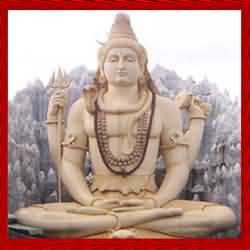 Shiva Statue on Airport Road
Shiva Statue on Airport Road
The huge Shiva Statue of Bangalore is located just behind the Total Mall in Murugeshpalya, old Airport Road. The Shiva statue in Bangalore is about 65 feet tall. The statue depicts Lord Shiva who is seated in Padmasana or Lotus posture (Meditating form).
The Shiva statue is white in color. The statue of Lord Shiva has four hands. The front two hands are placed on his lap with the fingers interlocked. The rear hands are equipped with a 'damaru' and a 'trishul' or trident. The background of Shiva Statue appears as if it is Mount Kailash, the heavenly abode of Lord Shiva. You can watch River Ganga flowing from the rocks of the idol. The Shiva statute looks superb during the night once it is lighted.
There is an attractive pond right in front of Shiva statue. It is believed that this is a wishing pond. People chant here "Om Namah Shivaya", 7 times and after that throw a coin in the pond while making a wish at the same time. It is believed that wish will surely come true.
You can also see 12 Jyotir Lingas here. All the 12 Jyotir Lingas are displayed with their related stories and proper description about their origin. You can also see a huge statue of Lord Ganesh at the entrance of the temple.

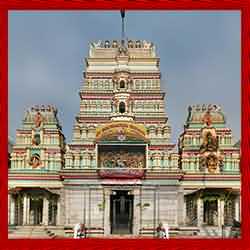 Dharmaraya Temple
Dharmaraya Temple
Shri Dharmaraya Swamy Temple is one of the oldest and famous temple situated in Bangalore city. It is unique as it is dedicated to the Pandavas and not found anywhere else in India.
Located in Nagarathpet, this temple has two exceptionally fine images of Lord Krishna and Dharmaraja - hero of the epic 'Mahabharata'. The temple is also well known for the annual Karaga festival. The Karaga festival - a form of Shakti worship, is celebrated during March/April of every year. The Karaga procession starts from the Dharmaraya temple at Nagarthpet at about 2 am. The Archeology survey department has undertaken the study of the stone, masonry and declared that the age of this temple is more than (800 years) .It is also learnt from the experiments that, the Kempegowda Gopuras (towers) were built in the four corners of the city keeping the Sri Dharmarayaswamy Temple vimanagopura kalasa as a centre point. It is Ulsoor tower in the North-East, The Bellary Road Tower in the North-West, The Lalbagh Tower in the South-East, The Gavipura Tower in the South-West to the temple, which gives more intensive relations to the Kempegowda's developmental works.

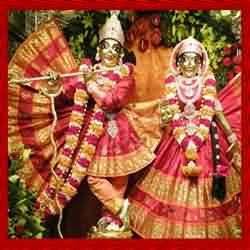 ISKCON Temple
ISKCON Temple
Sri Radha Krishna temple has deities of Radha and Krishna located at Rajajinagar, in the North Bangalore, Karnataka, India. It is one of the largest ISKCON temples in the world.
Sri Radha Krishna temple and cultural complex, which is an architectural masterpiece is set on a seven-acre hillock called the 'Hare Krishna Hill'. This is ISKCON's global project to commemorate the birth centennial of its founder Sri Prabhupada. Built in the Neo-Classical style, it combines traditional elements of temple architecture with high-tech utilities. Ornamental arches and illuminated water cascades lead to an elaborately decorated Rajagopuram. There is a unique open air amphitheatre for concerts and festivals.The four temple 'gopurams' are connected by a stunning glazed glass canopy which forms the main 'Hari Naam Kirtan' - a hall of 10,000 square feet. The hall has wonderful ceiling paintings. There are also Vedic museums and exhibit areas, a lecture hall with multiple language translation system and landscaped gardens. The main attraction is ISKCON Vedic Theatre, where a multimedia Vedic film is shown.

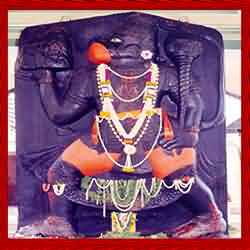 Prasanna Veeranjaneya Temple
Prasanna Veeranjaneya Temple
Sri Prasanna Veeranjaneya Temple is one of the most beautiful temples and also a must visit temple in Bangalore city.
The uniqueness of the Prasanna Veeranjaneya temple, apart from the 22-foot-high deity of Veeranjaneya, is its peaceful atmosphere. The cool breeze and surrounding greenery, coupled with an aura of mysticism, bring solace to devotees visiting the temple.Anjaneya / Hanuman Temple in Mahalakshmi Layout. This is one most beautiful and amazing temple. A must visit. Its about 40 years old. The temple also holds many yoga and meditation programmes. It is also house of Godess Mahalakshmi. Its star of Mahalakshmi layout area.
A huge monolith statue of Lord Hanuman which is painted ochre around the mouth (orange like color) and the left foot is cast in silver. Most auspicious temple deity, many people come and pray here. Since today is Tuesday, the crowds will be huge as Tuesday is the day people pray to Lord Hanuman. For the removal of all evil effects,praying to Lord Hanuman is very efficatious. The statue is of black rock, nearly 50 feet high and an over powering presence. This temple is very famous and power full. especially on new moon days comes on saturday it is very auspecious.

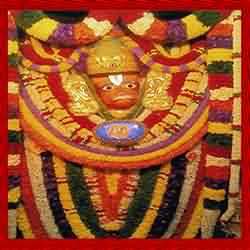 Gali Anjaneya Temple, Mysore Road
Gali Anjaneya Temple, Mysore Road
Gali Anjaneya (Hanuman) Temple is one of the oldest and sacred temples of Bangalore located in Mysore Road Byatarayanapura, the suburb of Bangalore.
Saint Sri Vyasaraya of Channapattana, a great philosopher and devotee to Lord Anjaneya has built around 732 temples for the Lord Anjaneya (Hanuman). It is believed that Sri Vyasaraya established this temple in the year 1425 at the convergence of two rivers - Vrishabhavathi and Paschimavahini (at present only industrial waste is flowing making Vrishabhavathi seem more similar to drain rather than river).
It is believed that once the idol of the Lord Anjaneya open to Gali (Gali means Air in Kannada language), hence the name Gali Anjaneya. It is also believed that since Anjaneya (Hanuman) is son of Vayu, the wind God therefore Gali Anjaneya.

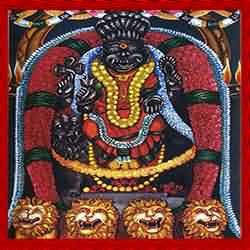 Pratyangira Devi Temple
Pratyangira Devi Temple
Pratyangira Devi Temple Bangalore, situated in Ashir kanna, St. John's road, opp to Lavanya Theatre, landmark near ulsoor lake Bangalore. Pratyangira sometimes called Prathyangira or Narashimhika, is a Hindu Goddess associated with Shakti, the Hindu concept of eternal energy. She is described as a goddess with a lioness's face and a human body. This combination of lion and human forms represents the balance of good and evil.
In Hindu mythology, Prathyangira is a fusion of Vishnu, Durga, Kali, and Narasimha.
Prathyangira is also mentioned in the Hindu epic Ramayana. Indrajit was performing "Nikumbala yaga" (a sacred ritual to worship Prathyangira) while Rama and his soldiers were waging war in Lanka. Hanuman came down to stop this ritual because he knew that if Indrajit completed it, he would become invincible.
